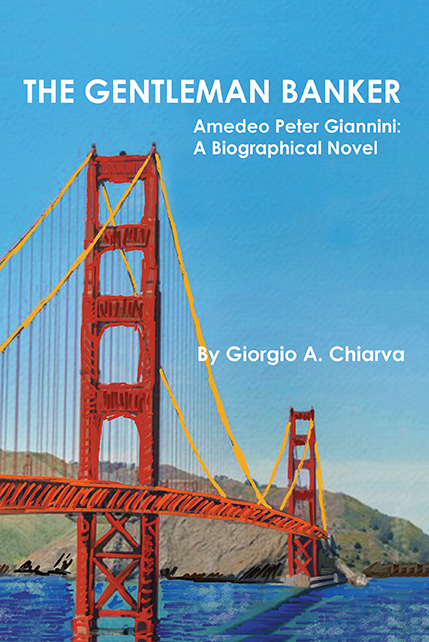
About the Author
Giorgio A. Chiarva has a degree in architecture and for forty years he has been an entrepreneur in the wood design industry. He also worked for a number of newspapers as a journalist and an administrator. He published two volumes of short stories, and this is his first novel.
From the Italian Press
“This is the saga of Amadeo Peter Giannini, the Italian banker who after the San Francisco earthquake loaned money to the poor and made California’s rebirth possible.” —Il Foglio.
“This biographical novel consists of short chapters dense with content. It offers a smooth and enticing reading, in an unadorned style which conveys the exceptional traits of Giannini’s life.” —Il sole 24 ore.
“Giannini was a visionary, who changed the rules of the game in the finance world by betting on the real economy rather than speculative financial schemes. He demonstrated that to be successful as a credit lender one must believe in the future.” —Conquiste del Lavoro.
“Generous, honest, visionary, forward-looking, and bold. Giannini refused money, titles, honors, and offices, but welcomed challenges, responsibilities, and opportunities.” ―Millionaire.
THE GENTLEMAN BANKER: Amadeo Peter Giannini. A Biographical Novel
Giorgio A. ChiarvaNew Academia Publishin/THESPRING, 2022
344 pages
ISBN 979-8-9852214-0-4 paperback
 See an excerpt from the book.
See an excerpt from the book.
For BULK ORDERS, order directly from New Academia Publishing.
Queries: orders@newacademia.com
About the Author
Giorgio A. Chiarva has a degree in architecture and for forty years he has been an entrepreneur in the wood design industry. He also worked for a number of newspapers as a journalist and an administrator. He published two volumes of short stories, and this is his first novel.
From the Italian Press
“This is the saga of Amadeo Peter Giannini, the Italian banker who after the San Francisco earthquake loaned money to the poor and made California’s rebirth possible.” —Il Foglio.
“This biographical novel consists of short chapters dense with content. It offers a smooth and enticing reading, in an unadorned style which conveys the exceptional traits of Giannini’s life.” —Il sole 24 ore.
“Giannini was a visionary, who changed the rules of the game in the finance world by betting on the real economy rather than speculative financial schemes. He demonstrated that to be successful as a credit lender one must believe in the future.” —Conquiste del Lavoro.
“Generous, honest, visionary, forward-looking, and bold. Giannini refused money, titles, honors, and offices, but welcomed challenges, responsibilities, and opportunities.” ―Millionaire.
THE GENTLEMAN BANKER: Amadeo Peter Giannini. A Biographical Novel
This biographical novel recounts the extraordinary intuitions of the Italian-American visionary founder of the world’s largest bank, the Bank of America.
Amadeo Peter, or AP for his San Francisco friends, dedicated his life to generate wealth for the people of his home town, in particular for the Italian immigrant’s community. He was an innovator and humanist, who always put the common good ahead of personal gain.
He revolutionized the banking system when he financed the reconstruction of San Francisco after the 1906 earthquake by making micro-loans to hundreds of Italian immigrants lacking collateral. The other banks, which required collateral in order to make a loan, were unable to put the money into circulation.
He was a visionary in the film industry, financing the movie, The Kid, by an unknown and extravagant Charlie Chaplin who was turned down by other banks. It was the first time a loan was granted without interest, and repaid from box office revenues. The same happened with Walt Disney for his masterpiece, Snow White. In addition, Giannini realized the potential of the new audio technology developed by two young inventors, Bill Hewlett and David Packard, and put them in touch with Disney for his following productions, and financed the industry that the two entrepreneurs began in a garage in Palo Alto.
Another successful project financed by Giannini’s bank was the construction of the Golden Gate Bridge, designed by Joseph Strauss, an engineer without solid credentials, as a daring steel structure. The loan was granted without interest, with the understanding that it would be repaid from toll revenues. And it did, many times over.
Giannini revealed his acumen as a venture capitalist when he persuaded Henry Kaiser to convert his enterprise from the construction of roads and bridges to ship building. During WWII, with Giannini’s encouragement, the shipyard was able to build 24 ships in record time, which were used to transport the troops to Europe.
After the war, Giannini’s bank contributed $37M to Italy’s reconstruction, one year in advance of the Marshall Plan.
And much more…This book tells it all.





 Coming Soon
Coming Soon Awards
Awards